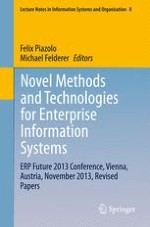This volume presents the revised and peer reviewed contributions of the ‘ERP Future 2013’ conference held in Vienna/Austria on November 12-13th, 2013.
The ERP Future 2013 Research conference is a scientific platform for research on enterprise information systems in general and specifically on core topics like business process management (BPM), business intelligence (BI) and enterprise resource planning (ERP) systems. Besides the scientific community the event also addresses businesses developing, implementing and intensively using enterprise information systems.
To master the challenges of enterprise information systems comprehensively, the ERP Future 2013 Research conference accepted contributions with a business as well as an IT focus to consider enterprise information systems from various viewpoints. This combination of business and IT aspects is a unique characteristic of the conference that resulted in several valuable contributions with high theoretical as well as practical impact.
